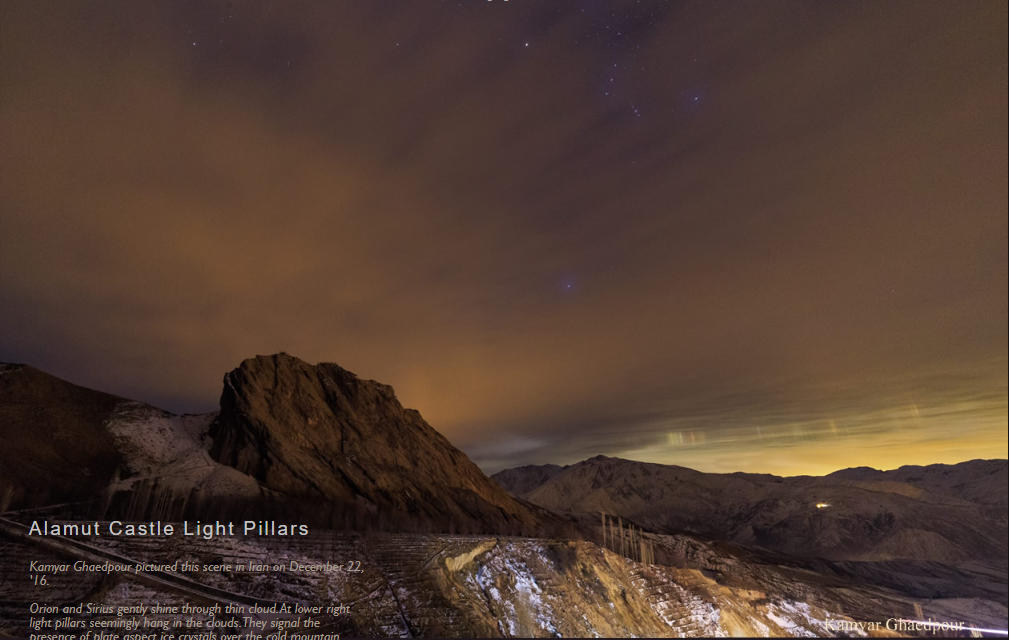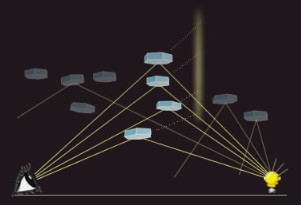Alamut, Iran, light pillars
Alamut, Iran: A Spectacular Display of Light Pillars
Alamut, Iran is not only known for its historical significance but also for its breathtaking atmospheric phenomena. One such phenomenon is the occurrence of light pillars that grace the night sky, creating a mesmerizing spectacle for onlookers. In this article, we will delve into the details of these light pillars and explore the science behind their formation.
The Enchanting Scene
On a chilly December night in 2016, Kamyar Ghaedpour captured a captivating image of Alamut Castle against the backdrop of a starry sky. In the image, Orion and Sirius gently shine through thin clouds, adding an ethereal touch to the scene. However, what truly steals the show are the light pillars that seemingly hang in the clouds at the lower right corner of the photograph.
Unraveling the Mystery
Light pillars are optical illusions created by the reflection of light from ice crystals suspended in the atmosphere. In the case of Alamut, Iran, these crystals take the form of plate-like structures. As the lights from Qazvin, located 55 kilometers away, illuminate the sky, the plate crystals intercept and reflect these lights back downwards. This phenomenon gives rise to the illusion of vertical pillars of light piercing through the clouds.
A Fascinating History
While Alamut Castle serves as a majestic foreground in the photograph, it also boasts a rich historical background. The castle traces its origins back to the 9th century and was initially constructed under the rule of Vahsudan, a Justanid ruler. Throughout its eventful history, Alamut Castle witnessed significant milestones, including the establishment of a renowned library housing astronomical instruments.
The Science Behind Light Pillars
To understand how light pillars form, it is crucial to grasp the role of ice crystals in the atmosphere. These crystals can take various shapes, including plates, columns, and needles. In the case of light pillars, plate-like ice crystals are responsible for the mesmerizing display. Unlike sun pillars, which require the crystals to wobble from a horizontal position, the plate crystals in Alamut can remain stationary while reflecting the distant ground lights.
Exploring the Illusion
Light pillars have the ability to captivate our senses, evoking a sense of wonder and awe. To fully appreciate the magic behind these illusions, it is important to consider the following points:
- Light pillars are not physical structures but rather optical phenomena created by the reflection of light.
- The presence of thin clouds allows for the scattering and redirection of light, enhancing the visibility of the pillars.
- The angle at which the light enters and exits the ice crystals determines the height and shape of the pillars.
- Different types of ice crystals can produce varying patterns and colors within the light pillars, adding to their visual appeal.
The Beauty of Nature's Artistry
Alamut, Iran serves as a canvas upon which nature paints its breathtaking artwork. The convergence of historical architecture, celestial wonders, and atmospheric phenomena creates a harmonious symphony that mesmerizes all who witness it. The interplay between light and ice crystals in the formation of light pillars showcases the delicate balance of natural forces at work.
A Testament to Nature's Splendor
The photograph captured by Kamyar Ghaedpour not only immortalizes a fleeting moment but also reminds us of the immense beauty that surrounds us. Light pillars in Alamut, Iran offer a glimpse into the intricate dance between light and ice crystals, showcasing nature's ability to astonish and inspire. It is moments like these that remind us of the wonders that await us if we take the time to look up and appreciate the marvels of our atmosphere.
Conclusion
Alamut, Iran's light pillars stand as a testament to the captivating beauty found in our natural world. From the historical significance of Alamut Castle to the science behind the formation of these optical illusions, there is much to discover and appreciate. The next time you find yourself gazing at the night sky, take a moment to marvel at the wonders that unfold above and let the enchantment of light pillars transport you to a realm where nature's artistry knows no bounds.

Alamut Castle Light Pillars
Kamyar Ghaedpour pictured this scene in Iran on December 22, '16.
Orion and Sirius gently shine through thin cloud. At lower right light pillars seemingly hang in the clouds. They signal the presence of plate aspect ice crystals over the cold mountain scape. They reflect lights of Qazvin 55 km away.
The foreground is dominated by Alamut Castle (Eagle's Nest). Its origins go back to the 9th Century Justanid ruler Vahsudan. Its history was eventful, including the foundation of a famous library with astronomical instruments.
Image ©Kamyar Ghaedpour, shown with permission

The pillars are illusions. They are the combined glints from plate crystals between the observer and distant ground lights. Their near horizontal faces reflect the lights back downwards. Unlike the formation of sun pillars, the crystals need not wobble from horizontal.
Note: this article has been automatically converted from the old site and may not appear as intended. You can find the original article here.
Reference Atmospheric Optics
If you use any of the definitions, information, or data presented on Atmospheric Optics, please copy the link or reference below to properly credit us as the reference source. Thank you!
-
<a href="https://atoptics.co.uk/blog/alamut-iran-light-pillars/">Alamut, Iran, light pillars </a>
-
"Alamut, Iran, light pillars ". Atmospheric Optics. Accessed on November 26, 2024. https://atoptics.co.uk/blog/alamut-iran-light-pillars/.
-
"Alamut, Iran, light pillars ". Atmospheric Optics, https://atoptics.co.uk/blog/alamut-iran-light-pillars/. Accessed 26 November, 2024
-
Alamut, Iran, light pillars . Atmospheric Optics. Retrieved from https://atoptics.co.uk/blog/alamut-iran-light-pillars/.